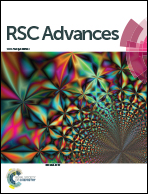Enhanced biocompatibility in poly(3-hexylthiophene)-based organic thin-film transistors upon blending with poly(2-(2-acetoxyacetyl)ethyl methacrylate)†
Abstract
Polymer blends with both biocompatibility and organic thin film transistor (OTFT) characteristics are developed by mixing a biocompatible polymer, poly(2-(2-acetoxyacetyl)ethyl methacrylate) (PHEMAAA) and a conducting polymer, poly(3-hexyl thiophene) (P3HT) at different weight ratios (i.e. P3HT/PHEMAAA = 75/25, 50/50, 25/75). Their OTFT performances were maintained at a similar level to those of pristine P3HT in spite of adding an insulator in the form of PHEMAAA. On the other hand, the biocompatibility of the P3HT/PHEMAAA blend films was found to be as good as that of PHEMAAA, indicating the successful contribution of the biocompatible polymer. In particular, these combined properties were optimized at a 25/75 weight ratio as described above. These results could be correlated with surface properties such as molecular orientation, morphology, and composition that change upon blending. Such P3HT/PHEMAAA blends are promising materials for applications in biomedical fields where materials come into contact with the human body.


 Please wait while we load your content...
Please wait while we load your content...